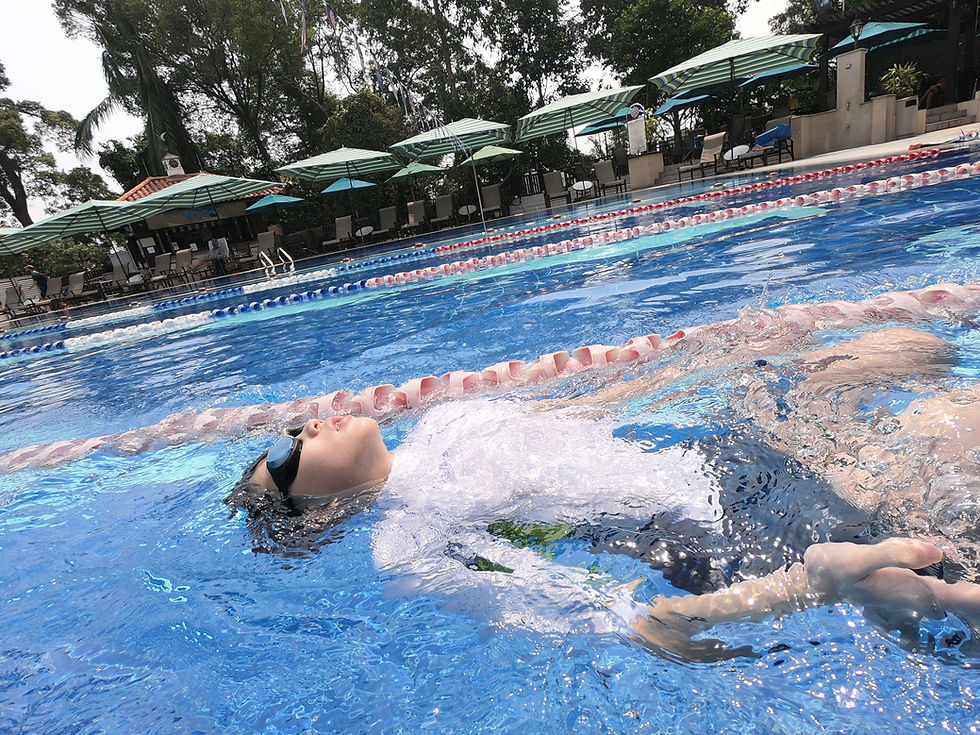Improving Backstroke Push-Off Without Coaching: A Self-Guided Approach
- SG Sink Or Swim

- Jun 22
- 2 min read

A strong push-off is essential to maximizing your speed and momentum in backstroke swimming. For those training solo or without a coach, improving your backstroke push-off can feel tricky — but it’s entirely possible with the right approach. With a blend of awareness, repetition, and targeted drills, you can sharpen this critical skill on your own.
In this article, we’ll break down how to improve your backstroke push-off independently, giving you a clear roadmap to faster starts, smoother transitions, and better race performance.
🧠 Why the Push-Off Matters in Backstroke
The push-off — whether from a wall or the start — is often the fastest part of your swim. It sets the tone for the rest of the length by:
Maximizing initial velocity
Enhancing streamline and distance
Improving underwater dolphin kick execution
Reducing drag and energy waste
A poor push-off leads to lost momentum, inefficient breakouts, and extra effort to regain speed.
🔍 Key Elements of an Effective Backstroke Push-Off
To self-correct and refine your push-off, focus on these fundamentals:
Foot Position
Place your feet hip-width apart, toes pointed slightly outward.
Heels should be slightly below the surface on the wall.
Body Angle
Push off in a tight streamline at about a 5–10 degree downward angle.
Avoid pushing straight back or downward too steeply.
Streamline
Arms extended and squeezed behind the ears.
Hands stacked, head neutral, core tight.
Underwater Kick Timing
Begin dolphin kicks after a brief glide (0.5–1 second).
Break out just before you lose momentum.
🛠️ Drills and Exercises to Practice Push-Off Solo
1. Wall Push-Off Repeats
Start in the water, push off with perfect form.
Glide as far as possible, no kicks.
Track your distance each time to measure improvement.
✅ Focus on a tight streamline and consistent push angle.
2. Streamline Kick and Breakout Drill
Push off and perform 3–6 dolphin kicks before breaking out.
Time your transition from underwater to your first stroke.
✅ Improves rhythm and breakout control.
3. Mirror or Camera Feedback
Use a waterproof camera or reflective pool mirror (if available).
Record your push-off or observe your underwater form.
✅ Visual feedback is invaluable when training alone.
4. Vertical Jump Simulation (Dryland)
Practice explosive jumps against a wall to mimic the motion of a push-off.
Focus on leg drive and core engagement.
✅ Builds explosive power and muscle memory.
5. Streamline Tightness Drill
Practice streamline holds on land (lying on back) or in the water.
Hold for 10–20 seconds and focus on full-body tension.
✅ Teaches proper body alignment and control.
🧘♂️ Tips for Solo Training Success
🕒 Practice push-offs every swim session — repetition builds consistency.
📏 Use pool tiles or lane markings to track glide distance.
📹 Film yourself every few weeks to assess progress.
🧠 Mentally rehearse push-off technique before each attempt.
⚠️ Focus on quality, not quantity — don’t reinforce poor form.
🏁 Final Thoughts
You don’t need a coach to develop a faster, more powerful backstroke push-off. By focusing on technique, building body awareness, and using simple tools like repetition, mirrors, or video, you can make real progress on your own. Combine this with smart drills and consistency, and you’ll see measurable gains in your backstroke performance — all from self-guided training.





Comments